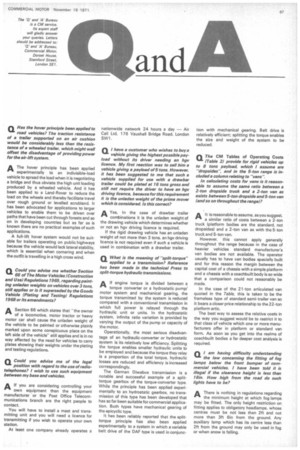n What is the meaning of "split-torque" applied to a
Page 65

If you've noticed an error in this article please click here to report it so we can fix it.
transmission? Reference has been made in the technical Press to split-torque hydraulic transmissions.
A If engine torque is divided between a ^ torque converter or a hydrostatic pump! motor system and mechanical gearing, the torque transmitted by the system is reduced compared with a conventional transmission in which full power is relayed through the hydraulic unit or units. In the hydrostatic system, infinite ratio variation is provided by varying the output of the pump or capacity of the motor.
Operationally, the most serious disadvantage of an hydraulic-converter or hydrostatic system is its relatively low efficiency. Splitting the torque enables smaller hydraulic units to be employed and because the torque they relay is a proportion of the total torque, hydraulic losses are reduced and efficiency is increased correspondingly.
The German Diwabus transmission is a notable and successful example of a splittorque gearbox of the torque-converter type. While the principle has been applied experimentally to an hydrostatic gearbox. no transmission of this type has been developed that has so far been suitable for commercial application. Both types have mechanical gearing of the epicyclic type.
It has been reliably reported that the splittorque principle has also been applied experimentally to a system in which a variable belt drive of the DAF type is used in conjunc
bon with mechanical gearing. Belt drive is relatively efficient; splitting the torque enables the size and weight of the system to be reduced.




















































































































